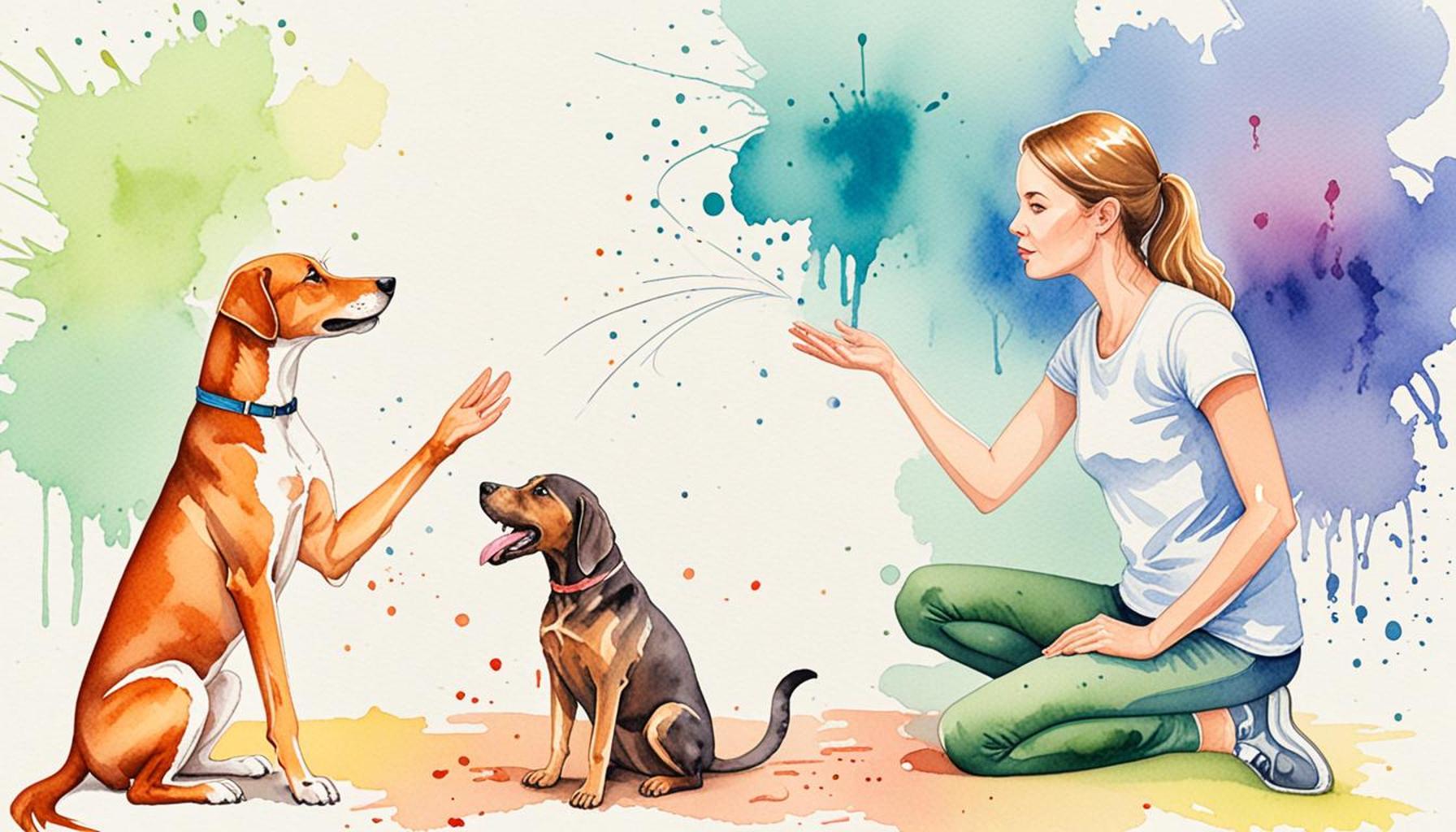Positive Dog Training Building Trust and Bonds with Your Canine

Establishing a harmonious relationship with your canine companion begins with effective training. Over the years, pet owners have discovered that positive training methods not only promote good behavior but also foster a deep sense of trust and understanding. This approach shifts the focus from traditional punishment to encouragement, creating a safer and more enjoyable environment for both dogs and their owners.
Research shows that positive reinforcement can lead to lasting behavioral changes, improving the overall well-being of our furry friends. By employing techniques that reward good behavior rather than penalizing bad actions, owners can cultivate a strong bond with their pets. Understanding this concept is essential for anyone looking to enhance their relationship with their dog.
As we delve into this topic, we’ll explore the Top 5 Benefits of Positive Dog Training that highlight its significance in building trust and a lasting connection. Whether you’re a new pet parent or an experienced dog owner, these insights will provide valuable knowledge for nurturing your canine companion.
DIVE DEEPER: Click here to discover the perfect routine for your energetic pup
Top 5 Importance of Positive Training in Dogs: Building a Trusting Bond
Training a dog effectively is not only about the mechanical execution of commands; it’s an art form that revolves around nurturing a meaningful relationship between a canine and its human counterpart. Among the myriad of dog training methodologies, positive reinforcement has emerged as the frontrunner, celebrated for its role in cultivating a vibrant bond built on trust, engagement, and happiness. Here, we delve into the five pivotal reasons why positive training plays a crucial role in constructing and enriching this bond.

5. Enhances Communication
The crux of any strong relationship, human or animal, is grounded in effective communication. Through positive reinforcement training methods, owners provide clarity on the expected behaviors by rewarding good conduct. This establishes a feedback loop where dogs start to interpret cues and commands more precisely, while owners become adept at reading their pet’s signals.
Examples of positive communication tactics are manifold:
- Utilizing consistent verbal commands to avoid confusion
- Observing the dog’s body language to gauge their comfort and understanding
- Maintaining an approachable and upbeat demeanor that encourages communication
As this two-way communication strengthens, the dog’s responses improve, making them more amenable to commands and fostering a harmonious cohabitation. This mutual understanding not only bridges the communication gap but also deepens the connection between the owner and the dog.
4. Builds Confidence
Confidence is an intangible yet crucial attribute that is significantly bolstered in dogs through positive training techniques. When dogs are rewarded for their successes, their self-assurance receives a boost, which reflects in their willingness to explore and embrace new experiences. Training sessions where praise is abundant not only uplift a dog’s spirits but also equip them to face new challenges with enthusiasm.
This development of confidence manifests in numerous ways:
- Significantly reduced anxiety in unfamiliar environments or social situations
- A dog eager to learn and perform new tricks or behaviors
- An adaptable temperament allowing them to adjust to changes in their surroundings
This newfound confidence transcends training sessions, permeating everyday interactions and ensuring a more pleasant experience for both the dog and the owner. A confident dog that approaches the world with curiosity rather than fear is less likely to exhibit problematic behaviors often rooted in insecurity or anxiety.
3. Encourages Better Behavior
The environment created by positive reinforcement is uniquely conducive to encouraging good behavior. By focusing on rewarding desirable actions rather than punishing mistakes, dogs are conditioned to associate behavioral compliance with positive outcomes. This approach not only trains dogs more efficiently but also contributes to a more peaceful home environment.
Extensive research underscores the efficacy of positive training, highlighting benefits such as:
- Enhanced compliance with commands due to the anticipation of rewards
- Significant improvements in social behaviors toward both humans and other animals
- A stronger bond during training sessions, as dogs develop a positive outlook towards learning
In this rewarding cycle, dogs learn to act positively to meet the desired outcomes, leading to not only a reduced incidence of behavioral issues but also a healthier and happier lifestyle for the pet.
2. Strengthens the Human-Animal Bond
The bond between a dog and its owner is a unique and deeply rewarding connection that positive training significantly enhances. Through a training approach that focuses on encouragement and appreciation, dogs develop a deeper level of trust in their human companions. This trust lays the foundation for a lasting emotional bond that enriches the lives of both parties.
Strengthening this bond brings with it several tangible benefits:
- An increased sense of security for the dog, knowing they are loved and understood
- Greater engagement during training, as the dog is motivated by its owner’s positive reinforcement
- A long-term partnership grounded in respect and affection, reducing behavioral complications
By nurturing this sense of companionship, owners not only bring more joy into their dogs’ lives but also reap the emotional rewards of their efforts, leading to fewer behavioral nuances and more goodwill.
1. Fosters Long-Lasting Relationships
At the pinnacle of positive training’s benefits is its capacity to foster relationships that stand the test of time. The principles of positive training craft an immediate sense of camaraderie while setting the stage for future interactions. As dogs experience consistent affirmation, they cultivate a perception of their owners as supportive and reliable allies.
Enduring relationships blossoming from positive reinforcement carry extraordinary value:
- The nurturing of a loyal and affectionate pet that cherishes and trusts its owner
- A continual learning curve where each day brings mutual enjoyment and discovery
- Shared fulfillment and satisfaction derived from a thriving owner-pet bond
These robust relationships form the cornerstone of an enriched and gratifying pet ownership journey, wherein the experiences shared are characterized by trust, joy, and unwavering affection.
In conclusion, positive training in dogs transcends obedience, delving into the realm of relationship-building where mutual respect and affection reign supreme. This method not only enhances the bond between humans and their furry friends but also cultivates an environment conducive to continued growth and happiness for both.
| Category | Details |
|---|---|
| Effective Communication | Positive training fosters a clear communication channel between the dog and the owner, enabling better understanding of commands and expectations. |
| Behavior Modification | By focusing on rewarding good behavior rather than punishing the bad, positive reinforcement leads to lasting behavioral changes in dogs. |
| Building Trust | Consistent positive interactions build a foundation of trust and security, helping dogs feel safe in their environments. |
| Enhanced Socialization | Positive training supports better social skills by encouraging dogs to interact positively with other animals and people, reducing fear and anxiety. |
The positive impact of such training methods transcends just basic obedience. It has been shown that dogs trained under a positive reinforcement framework tend to exhibit lower levels of stress and anxiety, which not only facilitates their adaptation to new situations but also contributes significantly to their overall mental health. This is crucial in avoiding behavioral issues that may arise from fear-based training methods.Moreover, this method empowers owners to create a more engaging and enjoyable training experience, where learning becomes a game rather than a chore. The incorporation of play into training sessions not only enhances learning but also strengthens the emotional bond between the dog and the owner. It transforms mundane commands into fun challenges that dogs look forward to.Additionally, positive training encourages a more cooperative and enthusiastic response from dogs during training sessions. The reward-based approach taps into their natural instincts, often resulting in a more eager and happy learner. This inherent joy in training reflects positively not only in the dog’s behavior but also in the owner’s experience, fostering a mutual respect and admiration that is vital in the dog-owner relationship.In light of this evidence, the role of positive reinforcement in dog training stands out as an effective and humane approach that benefits both the canine and the handler, paving the way for a harmonious coexistence. As owners delve deeper into these training methodologies, they unlock the potential of their dogs while simultaneously enriching their own lives.
DISCOVER MORE: Click here for tips on creating a cozy play area for your feline friend
Frequently Asked Questions: Understanding Positive Dog Training
What is Positive Dog Training and how does it differ from traditional methods?
Positive Dog Training focuses on using rewards and incentives to encourage desired behaviors in dogs, rather than relying on punishment or negative reinforcement. This approach is fundamentally different from traditional methods, which often involve coercion or correction to gain compliance. Positive training emphasizes the creation of a safe learning environment, where trust is established and the dog is motivated through positive interactions. As a result, it often leads to a more cooperative and enthusiastic learning process for both the dog and the owner.
Why is building trust important in dog training?
Trust is a crucial component in the relationship between a dog and its handler. When trust is present, a dog is more likely to feel secure and confident, which can lead to better learning outcomes. Positive training techniques, by promoting non-threatening and supportive interactions, help build this trust. A strong bond of trust not only improves the effectiveness of training but also enhances the overall welfare and quality of life for the dog. Moreover, a trusting relationship can prevent behavioral issues and reduce anxiety in dogs.
Can all dogs benefit from Positive Training methods, regardless of age or breed?
Indeed, positive training methods are versatile and can be tailored to suit dogs of all ages and breeds. Whether you’re working with a boisterous puppy or a senior dog, the core principle of using rewards and positive reinforcement remains effective. Each dog may have different preferences when it comes to rewards—some may respond better to treats, while others might prefer toys or verbal praise. Understanding these individual differences is key to successfully applying positive training. The adaptability of this approach allows it to be customized to meet the specific needs and motivations of each dog, leading to personalized and effective training sessions.
Are Positive Dog Training methods scientifically supported?
Yes, many studies in animal behavior and psychology support Positive Dog Training methods. Research has shown that positive reinforcement can improve learning speed, increase retention, and enhance the dog’s problem-solving abilities. The scientific community generally agrees that non-aversive methods, such as those used in Positive Dog Training, not only foster a more humane approach to training but also provide healthier outcomes for dogs. By focusing on rewards rather than punishment, these methods align with contemporary best practices in animal training.
What are some common misconceptions about Positive Dog Training?
One common misconception is that Positive Dog Training is less effective for addressing serious behavioral issues. On the contrary, this approach has been successfully used to modify even challenging behaviors, such as aggression and anxiety. Another myth is that it spoils the dog, making it undisciplined. However, when consistently applied, positive training can teach dogs boundaries and discipline without instilling fear. It’s designed not only to encourage desirable behaviors but also to strengthen the relationship between dogs and their owners.
DISCOVER MORE: Click here for stress-free RV travel tips with your pet
Building a Lasting Connection
In reflecting upon the significance of positive training methods for dogs, it is essential to understand their profound impact on both the mental and emotional well-being of our canine companions. Throughout this article, we have explored various facets of positive reinforcement and its invaluable role in establishing a deep and trusting relationship between dogs and their owners.
One of the most compelling trends in positive training is its focus on rewarding desirable behaviors rather than punishing unwanted ones. This shift not only reduces fear and anxiety in dogs but also fosters a more productive and enjoyable learning environment. Furthermore, the emphasis on consistency and patience allows dogs to build confidence and a sense of security, creating a harmonious dynamic between pet and owner.
Key Takeaways: A Path Toward Mutual Respect
- Building trust: Positive reinforcement is foundational in developing a sense of trust between dogs and their owners. By focusing on rewards, dogs are more eager to learn and comply.
- Enhancing communication: Positive training aids in the development of clearer communication channels, promoting understanding and cooperation.
- Strengthening the bond: This approach nurtures a closer and more affectionate bond, leading to long-term companionship.
- Mitigating behavioral issues: Many common behavioral problems can be effectively addressed through consistent positive reinforcement, reducing frustration for both parties.
- Fostering a peaceful coexistence: The overall household environment becomes more harmonious, benefiting everyone involved.
In conclusion, exploring the benefits of positive training sheds light on the importance of treating dogs with kindness and respect, laying the groundwork for a resilient bond steeped in mutual respect. As more pet owners embrace these methods, the shift will inevitably lead to more fulfilling relationships, where trust, understanding, and shared joy become the cornerstones of communication. For those keen to delve deeper, further study and practical application of these techniques can illuminate new paths to enriching the lives of our four-legged companions.


